The Canadair CL-415 commonly called the Scooper was the first model in a series of firefighting flying boat amphibious aircraft built by Canadian Air and later Bombardier. The CL-415 is a twin engine, high-dash wing aircraft designed to operate well at low speed and in gust loading circumstances, as are found over forest fires. It is also able to land and take off from short unpaved airstrips.
Below are a few key pieces of information related to the CL-415 that supplement the Review printed in Fly RC Magazine.
To see the full article on the Canadair CL-415… see the June 2012 Issue of Fly RC Magazine on sale now!
AT A GLANCE
MANUFACTURER: KMP, Kondor Model Products
DISTRIBUTOR: KMP, Kondor Model Products
TYPE: Sport Scale ARF Seaplane
FOR: Intermediate Sport Pilot
PRICE: $159.95
ASSEMBLY
The kit arrived unscathed and hardware is supplied to complete most of the assembly. There were no female plugs to wire into the motor connectors so I picked some up at my local hobby store in order to hook the speed controllers to the motors.
I installed the tail servo before the tail was assembled which makes it easier to run the servo wires to the front of the fuselage.
Glue is supplied for the assembly of the foam parts. Be careful when using tape to hold pieces together such as the wing halves because the tape can lift off the paint scheme. Use low tack painter’s tape.
Once all the parts were glued together, I installed the radio equipment. The two aileron servos were installed with 3M double sided tape, and for the servo covers, which reduce water on the servos, I used clear packing tape to secure them.
There are two sets of props so you have a spare set. You can set the props up in a counter rotation to reduce torque of the aircraft. To do this you need to play with the leads of the motors to get the proper rotation.
Be careful attaching the aileron horns. The caps are stiff and need firm pressure to slip them on to the horn stem. If you slip with your fingers, you can leave a big dent in the surface of the aileron.
Take your time in positioning the transfers because once in place they cannot be moved, or if you try to move them, you’ll pull the paint off the foam. I measured carefully and put faint marks on the sides of the fuselage so all the transfers were equally distributed on each side.
The braces for the sponsons were bare plywood so I took some yellow Testors paint to finish them off so they blended in with the rest of the aircraft.
This was the first time I assembled an electric twin, so I asked some of my electric buddies for advice on the most efficient way to hook up the speed controllers to my receiver. The advice I received was to make a Y harness for the battery. The two positive leads of the speed controller combine to the positive lead on the battery, and the two negative leads of the speed controller were combined to the negative pole of the battery. In hooking up the speed controllers to the throttle and the receiver, I took a Y connector and hooked the speed controllers into the Y connector, but I modified one speed controller in the following way: I pushed the red lead out of the plug of one of the speed controllers and taped it back on itself so it was disconnected from the receiver. I did not cut the wire because if I wanted to use the speed controller for something else later, all I would have to do was push the pin back into the plug. I activated the plane and both motors worked fine.
It took a few nights to assemble, getting the setup with proper distance throws and allowing the glue to dry, but when all was said and done, with a little patience, the plane turned out quite well and was ready for a first flight off the lake. From a stand off distance, the CL-415 has the scale appearance of the full scale firefighter.
 |
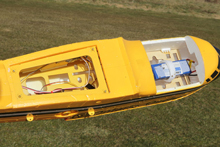 |
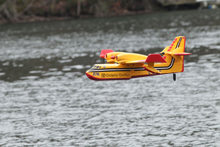 |
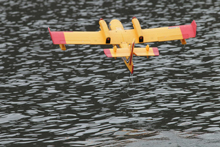 |
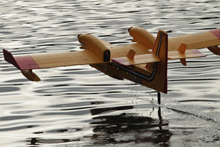 |
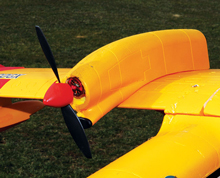 |
Links:
Castle Creations
Futaba
Hitec
Kondor Model Products
Thunderpower RC
By: Cliff Becker
Photos By: Walter Sidas
 Fly RC Magazine WE LIVE RC
Fly RC Magazine WE LIVE RC
